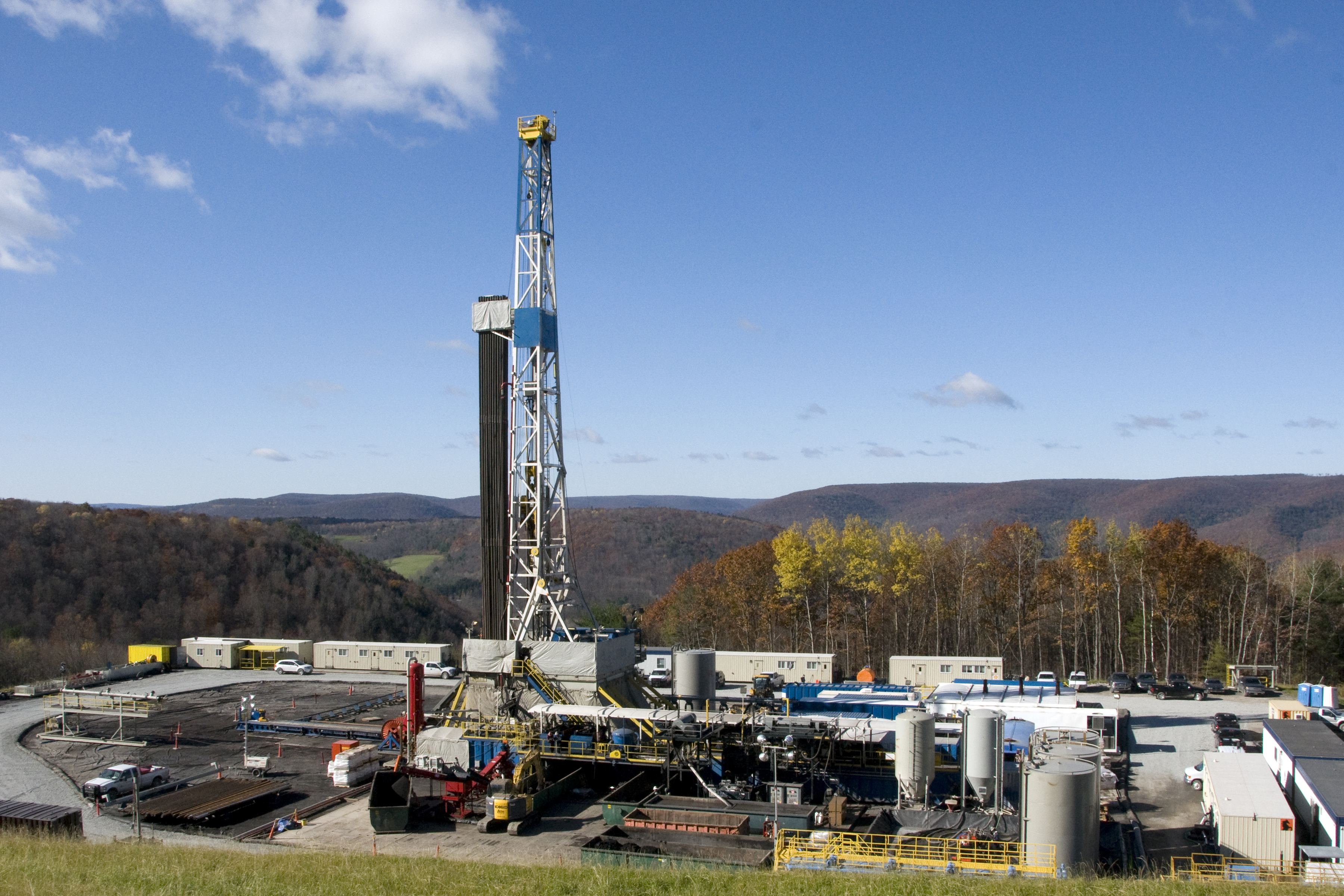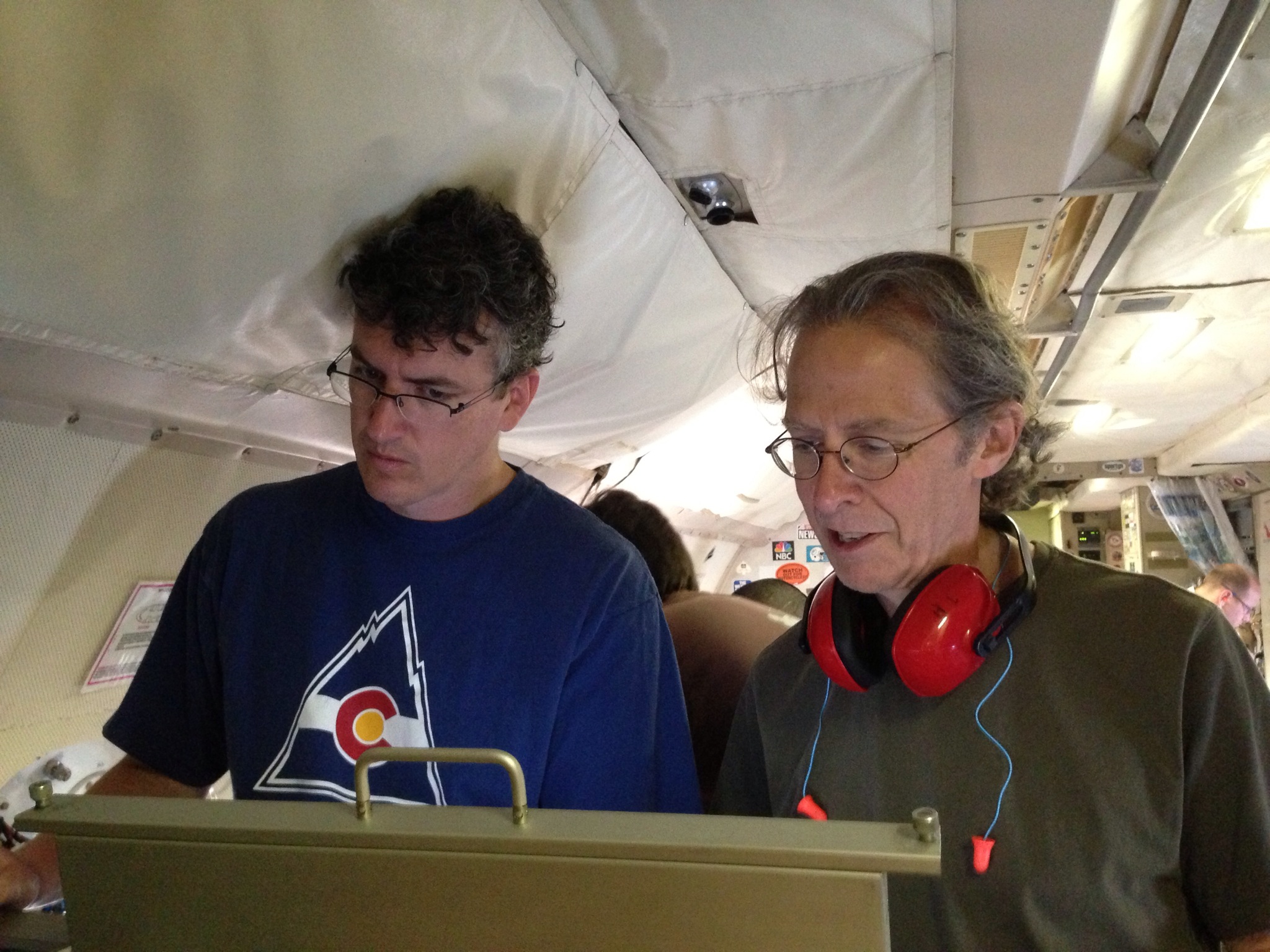Researchers measure lower emissions of the greenhouse gas than at some other sites
18 February 2015
WASHINGTON, D.C. — Tens of thousands of pounds of methane leak per hour from equipment in three major natural gas basins that span Texas, Louisiana, Arkansas and Pennsylvania, according to airborne measurements published today. But the overall leak rate from those basins is only about one percent of gas production there—lower than leak rates measured in other gas fields, and in line with federal estimates.

A new study finds that methane leaks from three large regions of natural gas development — including the Marcellus Shale where this Tioga County, Pennsylvania rig was built — are in line with federal estimates, about 1 percent of production.
CREDIT: Chuck Anderson, Earth and Environmental Systems Institute, Penn State
“We are beginning to get a sense of regional variation in methane emissions from natural gas production,” said lead author Jeff Peischl, a scientist with the Cooperative Institute for Research in Environmental Sciences (CIRES) in Boulder, Colorado. “The gas fields we studied for this paper produced about 20 percent of the natural gas in the United States, and more than half the shale gas, so this moves us closer to understanding methane leaks from U.S. natural gas production.”
Peischl’s team’s analysis appears online today in the Journal of Geophysical Research: Atmospheres, published by the American Geophysical Union.
In the new paper, Pieschl and his colleagues used sophisticated measurements taken from a research aircraft of the National Oceanic and Atmospheric Administration (NOAA) to determine methane emissions from the Haynesville, Fayetteville, and Marcellus regions during five flights in the summer of 2013. CIRES is a partnership of NOAA and the University of Colorado Boulder.
Overall, the team found that methane leaking from gas equipment totaled about 1.1 percent of gas produced in those regions; estimates from the Environmental Protection Agency, based on average equipment leak rates, put that figure at about 1 percent.

Scientists Jeff Peischl and John Holloway check atmospheric instrument data before a research flight in the summer of 2013.
Credit: Joost de Gouw, CIRES
“It is good news that our atmospheric measurements are close to the EPA estimates,” said co-author Joost de Gouw, a CIRES scientist who also works at NOAA. “If leak rates are too high, natural gas does not compare favorably with one alternative, coal, in terms of climate impact. Where leak rates are low, the comparison favors natural gas.”
In the new study, the researchers also reported their findings by region:
- Methane emissions in the Marcellus region of northeastern Pennsylvania were about 16.5 tons (33,000 lbs) per hour, or 0.18-0.41 percent of production.
- Methane emissions in the Haynesville shale of eastern Texas/northwestern Louisiana of about 88 tons (176,000 lbs) per hour, or 1.0-2.1 percent of production.
- Methane emissions in the Fayetteville shale region of Arkansas were roughly 43 tons (86,000 lbs) per hour, or 1.0-2.8 percent of produced gas.
In other published papers, CIRES, NOAA and other researchers have found methane losses of:
- about 4 percent of natural gas production in the Denver-Julesberg Basin
- 6-12 percent of natural gas production in Utah’s Uinta Basin (also called Uintah)
- about 17 percent of natural gas production in the Los Angeles Basin
The Colorado, Utah and California basins combined produce less than 3 percent of all U.S. natural gas, much less than the eastern basins.

Current shale gas “plays” or fields in the continental United States. Orange areas are current fields, red are prospective ones, and geologic basins are marked in beige.
SOURCE: U.S. Energy Information Administration
www.eia.gov/oil_gas/rpd/shale_gas.jpg
The variable methane leak rates in the different studies suggests that other chemicals emitted during gas production, including compounds that contribute to episodes of poor air quality, are also variable, de Gouw said. There could be many reasons for significant regional differences in leak rates, he added. The composition of gas can vary across different regions, with slightly more or less methane, for example. And equipment, techniques and regulations vary, as well.
The CIRES and NOAA team is planning another aircraft mission this spring, to expand emissions measurements from gas-producing regions stretching from Texas to North Dakota. The researchers hope that, taken together, the studies will help industry identify the conditions and techniques that minimize the leaks during gas production, benefitting both the atmosphere and the industry’s bottom line.

Scientists used this NOAA research aircraft in 2013 to fly over large segments of the U.S. Southeast, to better understand air quality and climate issues in the region. The mission found that methane leaks from three large regions of natural gas development were in line with federal estimates, about 1 percent of production.
Credit: David Oonk, CIRES
Pieschl works at NOAA’s Earth System Research Laboratory in Boulder.
###
The American Geophysical Union is dedicated to advancing the Earth and space sciences for the benefit of humanity through its scholarly publications, conferences, and outreach programs. AGU is a not-for-profit, professional, scientific organization representing more than 60,000 members in 139 countries. Join the conversation on Facebook, Twitter, YouTube, and our other social media channels.
Notes for Journalists
Journalists and public information officers (PIOs) of educational and scientific institutions who have registered with AGU can download a PDF copy of this article by clicking on this link: http://onlinelibrary.wiley.com/enhanced/doi/10.1002/2014JD022697/
Or, you may order a copy of the final paper by emailing your request to Peter Weiss at [email protected]. Please provide your name, the name of your publication, and your phone number.
Neither the paper nor this press release is under embargo.
“Quantifying atmospheric methane emissions from the Haynesville, Fayetteville, and northeastern Marcellus shale gas production regions”
Authors
Jeff Peischl: Cooperative Institute for Research in Environmental Sciences, University of Colorado Boulder,Boulder, Colorado, USA; and NOAA Earth System Research Laboratory (ESRL), Chemical Sciences Division, Boulder, Colorado, USA;
T. B. Ryerson: NOAA Earth System Research Laboratory (ESRL), Chemical Sciences Division, Boulder, Colorado, USA;
K. C. Aikin, Joost A. de Gouw, J. B. Gilman, J. S. Holloway and B. M. Lerner: Cooperative Institute for Research in Environmental Sciences, University of Colorado Boulder,Boulder, Colorado, USA; and NOAA Earth System Research Laboratory (ESRL), Chemical Sciences Division, Boulder, Colorado, USA;
R. Nadkarni: Texas Commission on Environmental Quality (TCEQ), Austin, Texas, USA;
J. A. Neuman: Cooperative Institute for Research in Environmental Sciences, University of Colorado Boulder,Boulder, Colorado, USA; and NOAA Earth System Research Laboratory (ESRL), Chemical Sciences Division, Boulder, Colorado, USA;
J. B. Nowak: Cooperative Institute for Research in Environmental Sciences, University of Colorado Boulder,Boulder, Colorado, USA; and NOAA Earth System Research Laboratory (ESRL), Chemical Sciences Division, Boulder, Colorado, USA; now at Aerodyne Research, Inc., Billerica, Massachusetts, USA;
M. Trainer: NOAA Earth System Research Laboratory (ESRL), Chemical Sciences Division, Boulder, Colorado, USA;
C. Warneke: Cooperative Institute for Research in Environmental Sciences, University of Colorado Boulder,Boulder, Colorado, USA; and NOAA Earth System Research Laboratory (ESRL), Chemical Sciences Division, Boulder, Colorado, USA;
D. D. Parrish: NOAA Earth System Research Laboratory (ESRL), Chemical Sciences Division, Boulder, Colorado, USA.
Contact Information for Authors
Jeff Peischl, CIRES scientist, [email protected], 303-497-4849
Joost de Gouw, CIRES scientist, [email protected], 303-497-3878
Peter Weiss, [email protected], 202-777-7507
CIRES Contact:
Katy Human, [email protected], 303-735-0196